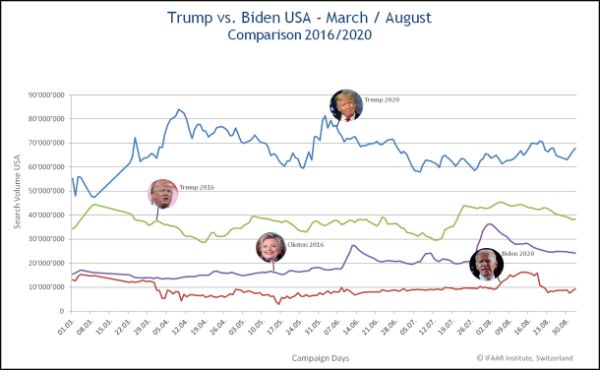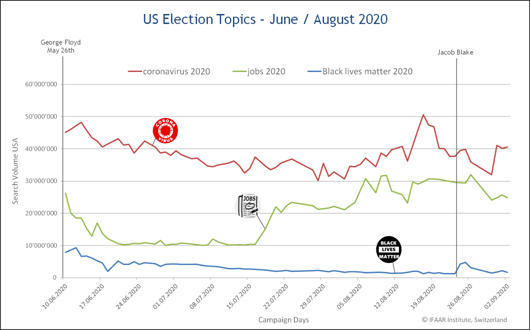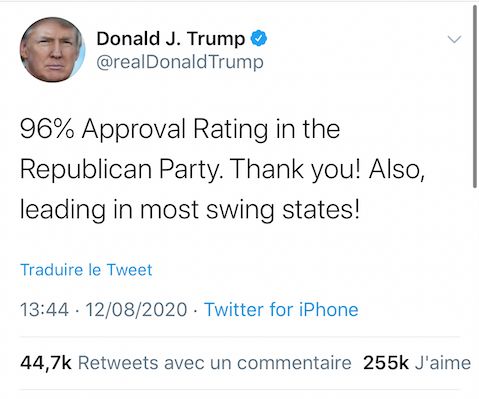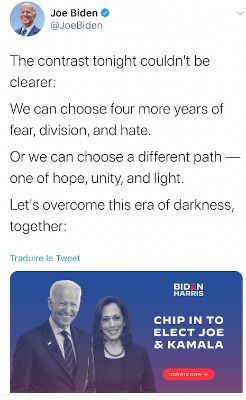Why Trump Can Win The Election
Swiss computer scientists have analysed the US Presidential election-campaign again
In the 2016 election campaign the prognosis and all digital channels betted on Hillary Clinton to win. A group of Swiss computer scientists, analysing the public campaign on all US search and social media channels in September 2016 already claimed that Donald Trump was going to win. In 2020 they show again, with new computer-based monitorings of the user behaviour in the US, that Donald Trump’s campaign is leading digitally with a five times bigger search volume than Joe Biden’s! The analysis of the candidates tweets shows that Trump uses rather strong emotions like “fear” and “anger” whereas Biden’s tweets insist on moral values and critizise the actions of the Trump administration during the pandemic. On both campaign websites, Trump also “beats” Biden by communicating 6% closer to the interest of American citizens online.
Search volume analysis
Thanks to a new innovative technology, the project UMUSE2* identifies the number of search requests sent in the US to all search engines, social media and e-shops, with the names of the two candidates, namely “Donald Trump” and “Joe Biden”, but also with all the topics high on search. Based on these numbers, Donald Trump has a significant lead over his rival. During the first two weeks in August 2020, Joe Biden's popularity has seen a short surge with the announcement of running mate Kamala Harris while the popularity of Donald Trump is decreasing only slowly since the beginning of June. Big data shows that Internet users on all US channels are still significantly more interested in Trump than in his opponent, the democrat Biden.

These numbers show that this year, the US election is basically a referendum for or against Donald Trump and that the Biden campaign didn’t even come close to Hillary Clinton’s search volume in 2016! “The presence on the Internet and the active involvement of the users is crucial, if one wants to win an election in the US”, tells Christoph Glauser, an election expert and Swiss political scientist.
The new technology also tracks the political demand of the citizens by monitoring the frequencies of numerous general topics (e.g., jobs and economy, healthcare, coronavirus or education). During the last two months, anonymous users in the US have been really concerned about the COVID-19, business and economy, but less about education. Compared to the 2016 campaign, Trump is again upfront with the search volumes on all important channels in the United States. Joe Biden couldn’t even “inherit” the online demand of Bernie Sanders, like Hillary did in 2016. Biden’s campaign didn’t come out of the lows during the whole summer of 2020. Whereas Trump inherited most of the digital user attention, astonishingly even more during the hot phase of the Black Lives Matter (BLM) movement.

For example, three of the most relevant topics during the presidential election are „coronavirus“, „jobs“ and „Black lives matter“. The figures show the volume on all the search engines, social media and e-shops during this summer. Black Lives Matter compares well with the “gun control” topic in 2016, where two shooting incidents, a terrorist attack in San Bernardino in December 2015 and the “Orlando” case, led to two strong peaks in the public search on gun control. In 2020 the same phhenomenon is comparable to the BLM cases with George Floyd and Jacob Blake. The digital attention for such topics is usually rising up relatively high, but loosing digital demand after a rather short period of time.
Twitter analysis
In addition, the tweets written by both candidates have been analyzed. On this social network channel, Trump is clearly more prolific with, in mean, 37 tweets per day (August) compared to 14 for Biden. Unlike the previous 2016 campaign, Trump retweets more (around 35%), a clue that he might be less involved. Unlike Biden, his tweets contain more references to other Twitter accounts (4.4% vs. 0.4%) but less hyperlinks (usually used to display a video). Trump's team often opts to repeat the same (or similar) tweet, up to 14 times for the “LAW & ORDER” tweet. The repetition of this kind of message (10% of Trump's tweets are repeated, in mean, 8 times), even false or misleading, achieves the intended objective. For example, following Trump’s repeated claims that the New York Times publishes fake news, only 8% of Republicans consider this newspaper as trustworthy. Looking at tweets’ contents, one can observe that Trump focuses on his opponent’s names (“sleepy Biden”, spelled sometime Bidan) or the “Radical Left” (occurring the first time June 30th, 2018). However, the media is still a good target for Trump as shown by the following tweet (May 16th, 2020) in which the terms Sleepy, Joe, Biden, Radical, Left, Lamestream, Fake, News, Media, crazy are specific to Trump’s vocubulary.

As an emotional person guided by his intuitions, Trump has adopted a fighting rhetoric, without defending his records and actions. Recurrently, a blame tone appears (e.g., bad, vicious, corrupt corresponding to 1% of the words), with concrete and easy to understand terms. His rhetoric, compared to Biden, presents a higher degree of tenacity and certainty with adverbs occurring to emphasis a grandiose pitch (e.g., great, incredible, powerful, 1.4% of the words). Currently, two topics are mainly ignored by Trump’s team, namely the immigrants and China.
If Trump’s tweets ignore the coronavirus (3% of his tweets in August), Biden puts this question forward (13.8% of his tweets). Trump insists on the security question (5.6% of tweets are about “police”) while Biden tweets about the moral values (e.g., integrity, freedom, darkness covering 26.7% of his tweets), on symbolic entities (e.g. nation, peace, freedom in 45% of his tweets), and on the voters and persons (35.7% with e.g., Americans, folks, public, voters). Moreover, Biden is focusing more on establishing a relationship with the audience (more we-words). To illustrate these aspects, our computer has selected this tweet (August 27th, 2020) that includes the following specific terms: lead, America, know, hard, folks, struggling, get, through, day, derseve, president, fight, nation, crisis,

“We are in a battle for the soul of this nation. And if we're going to get through these crises — we need to come together and unite for a better America. @KamalaHarris gets that — and I believe there's no better person to help me get the job done. ” (August 13th, 2020)
As a surprise, our analysis reveals that Biden’s tweets include the same levels of positive and negative emotions than those of Trump. Maybe the moral values will play a dominant role in this campaign.
Campaign website analysis
The two campign websites have also been analysed thorroughly by the team. Joe Biden is on https://joebiden.com/ and Donald Trump on https://www.donaldjtrump.com/. Astonishingly, despite what one would expect in (due to corona times) more digital campaigns, both websites are technically rather poorly built and are not following the latest standards offered by online marketing platforms at all. Compared to 2016, at least Donald Trump’s website of 2020 is more accessible and visible, even without a lot of security measures. It shows, among the usual fund raising attempts, his promises kept, and some links to videos and promotional material. Although it has a lot of technical obstacles limiting the visibility and performance of the site quite considerably.
Biden’s website is even worse. It fully blocks indexability and readability and misses content centric technologies, although it claims to take accessibility standards into account, it doesn’t apply them on the website at all. It is basically trying to collect donations – that is about it. Both candidates’ websites are missing a clear communication strategy or some consistence on their contents. Rather disapointing or already known old material and no real news on both sites.
Trump’s website wins over Biden’s, because his wording is 6% closer to the users in the US. If however, online is really important in the 2020 US elections, the scientists claim that Donald Trump is going to win the presidency again.

University of Neuchatel has a long tradition in computational linguistics with a team composed by Prof. Jacques Savoy and Loris Schmid (natural language processing) http:/www./unine.ch/iiun. The IFAAR Institute in Berne Switzerland has ten years of expertise in search & find software development and new media evaluation research, and is represented by Dr. Christoph Glauser (political- and mass media scientist https://ifaa.ch. This computer science research project has been financially supported, in part, by Hasler Foundation (Bern).
Any opinions, findings, conclusions, and/or recommendations are meant for mere scientific research purposes and are not intended to support any political views or campaigns.
*User Monitoring of the US Elections (UMUSE2).


 Keith Rankin: Make Deficits Great Again - Maintaining A Pragmatic Balance
Keith Rankin: Make Deficits Great Again - Maintaining A Pragmatic Balance Richard S. Ehrlich: China's Great Wall & Egypt's Pyramids
Richard S. Ehrlich: China's Great Wall & Egypt's Pyramids Gordon Campbell: On Surviving Trump’s Trip To La La Land
Gordon Campbell: On Surviving Trump’s Trip To La La Land Ramzy Baroud: Famine In Gaza - Will We Continue To Watch As Gaza Starves To Death?
Ramzy Baroud: Famine In Gaza - Will We Continue To Watch As Gaza Starves To Death? Peter Dunne: Dunne's Weekly - A Government Backbencher's Lot Not Always A Happy One
Peter Dunne: Dunne's Weekly - A Government Backbencher's Lot Not Always A Happy One Richard S. Ehrlich: Cyber-Spying 'From Lhasa To London' & Tibet Flexing
Richard S. Ehrlich: Cyber-Spying 'From Lhasa To London' & Tibet Flexing